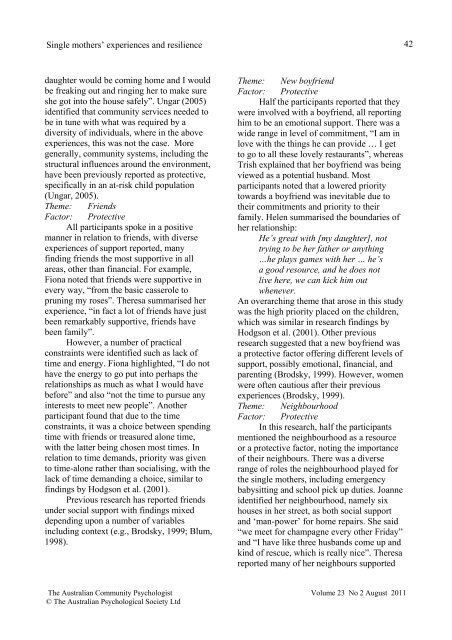The Australian Community Psychologist - APS Member Groups
The Australian Community Psychologist - APS Member Groups
The Australian Community Psychologist - APS Member Groups
Create successful ePaper yourself
Turn your PDF publications into a flip-book with our unique Google optimized e-Paper software.
Single mothers’ experiences and resilience<br />
42<br />
daughter would be coming home and I would<br />
be freaking out and ringing her to make sure<br />
she got into the house safely”. Ungar (2005)<br />
identified that community services needed to<br />
be in tune with what was required by a<br />
diversity of individuals, where in the above<br />
experiences, this was not the case. More<br />
generally, community systems, including the<br />
structural influences around the environment,<br />
have been previously reported as protective,<br />
specifically in an at-risk child population<br />
(Ungar, 2005).<br />
<strong>The</strong>me: Friends<br />
Factor: Protective<br />
All participants spoke in a positive<br />
manner in relation to friends, with diverse<br />
experiences of support reported, many<br />
finding friends the most supportive in all<br />
areas, other than financial. For example,<br />
Fiona noted that friends were supportive in<br />
every way, “from the basic casserole to<br />
pruning my roses”. <strong>The</strong>resa summarised her<br />
experience, “in fact a lot of friends have just<br />
been remarkably supportive, friends have<br />
been family”.<br />
However, a number of practical<br />
constraints were identified such as lack of<br />
time and energy. Fiona highlighted, “I do not<br />
have the energy to go put into perhaps the<br />
relationships as much as what I would have<br />
before” and also “not the time to pursue any<br />
interests to meet new people”. Another<br />
participant found that due to the time<br />
constraints, it was a choice between spending<br />
time with friends or treasured alone time,<br />
with the latter being chosen most times. In<br />
relation to time demands, priority was given<br />
to time-alone rather than socialising, with the<br />
lack of time demanding a choice, similar to<br />
findings by Hodgson et al. (2001).<br />
Previous research has reported friends<br />
under social support with findings mixed<br />
depending upon a number of variables<br />
including context (e.g., Brodsky, 1999; Blum,<br />
1998).<br />
<strong>The</strong>me: New boyfriend<br />
Factor: Protective<br />
Half the participants reported that they<br />
were involved with a boyfriend, all reporting<br />
him to be an emotional support. <strong>The</strong>re was a<br />
wide range in level of commitment, “I am in<br />
love with the things he can provide … I get<br />
to go to all these lovely restaurants”, whereas<br />
Trish explained that her boyfriend was being<br />
viewed as a potential husband. Most<br />
participants noted that a lowered priority<br />
towards a boyfriend was inevitable due to<br />
their commitments and priority to their<br />
family. Helen summarised the boundaries of<br />
her relationship:<br />
He’s great with [my daughter], not<br />
trying to be her father or anything<br />
…he plays games with her … he’s<br />
a good resource, and he does not<br />
live here, we can kick him out<br />
whenever.<br />
An overarching theme that arose in this study<br />
was the high priority placed on the children,<br />
which was similar in research findings by<br />
Hodgson et al. (2001). Other previous<br />
research suggested that a new boyfriend was<br />
a protective factor offering different levels of<br />
support, possibly emotional, financial, and<br />
parenting (Brodsky, 1999). However, women<br />
were often cautious after their previous<br />
experiences (Brodsky, 1999).<br />
<strong>The</strong>me: Neighbourhood<br />
Factor: Protective<br />
In this research, half the participants<br />
mentioned the neighbourhood as a resource<br />
or a protective factor, noting the importance<br />
of their neighbours. <strong>The</strong>re was a diverse<br />
range of roles the neighbourhood played for<br />
the single mothers, including emergency<br />
babysitting and school pick up duties. Joanne<br />
identified her neighbourhood, namely six<br />
houses in her street, as both social support<br />
and ‘man-power’ for home repairs. She said<br />
“we meet for champagne every other Friday”<br />
and “I have like three husbands come up and<br />
kind of rescue, which is really nice”. <strong>The</strong>resa<br />
reported many of her neighbours supported<br />
<strong>The</strong> <strong>Australian</strong> <strong>Community</strong> <strong>Psychologist</strong> Volume 23 No 2 August 2011<br />
© <strong>The</strong> <strong>Australian</strong> Psychological Society Ltd

















